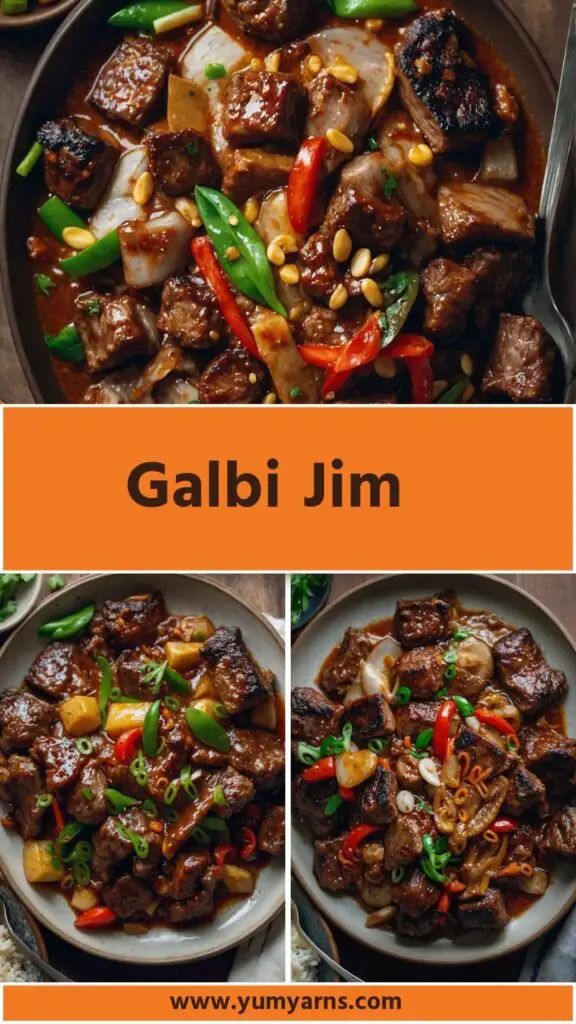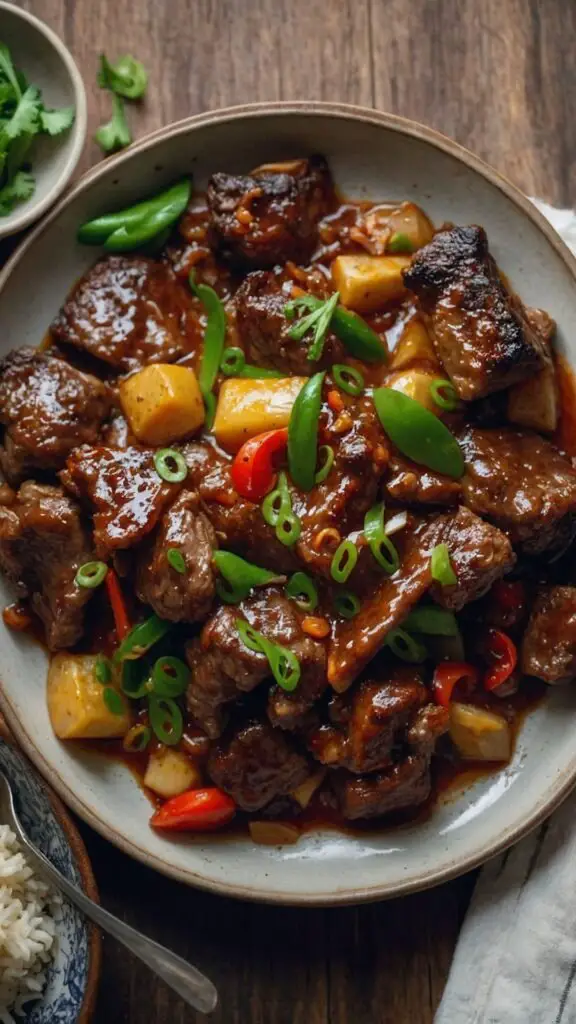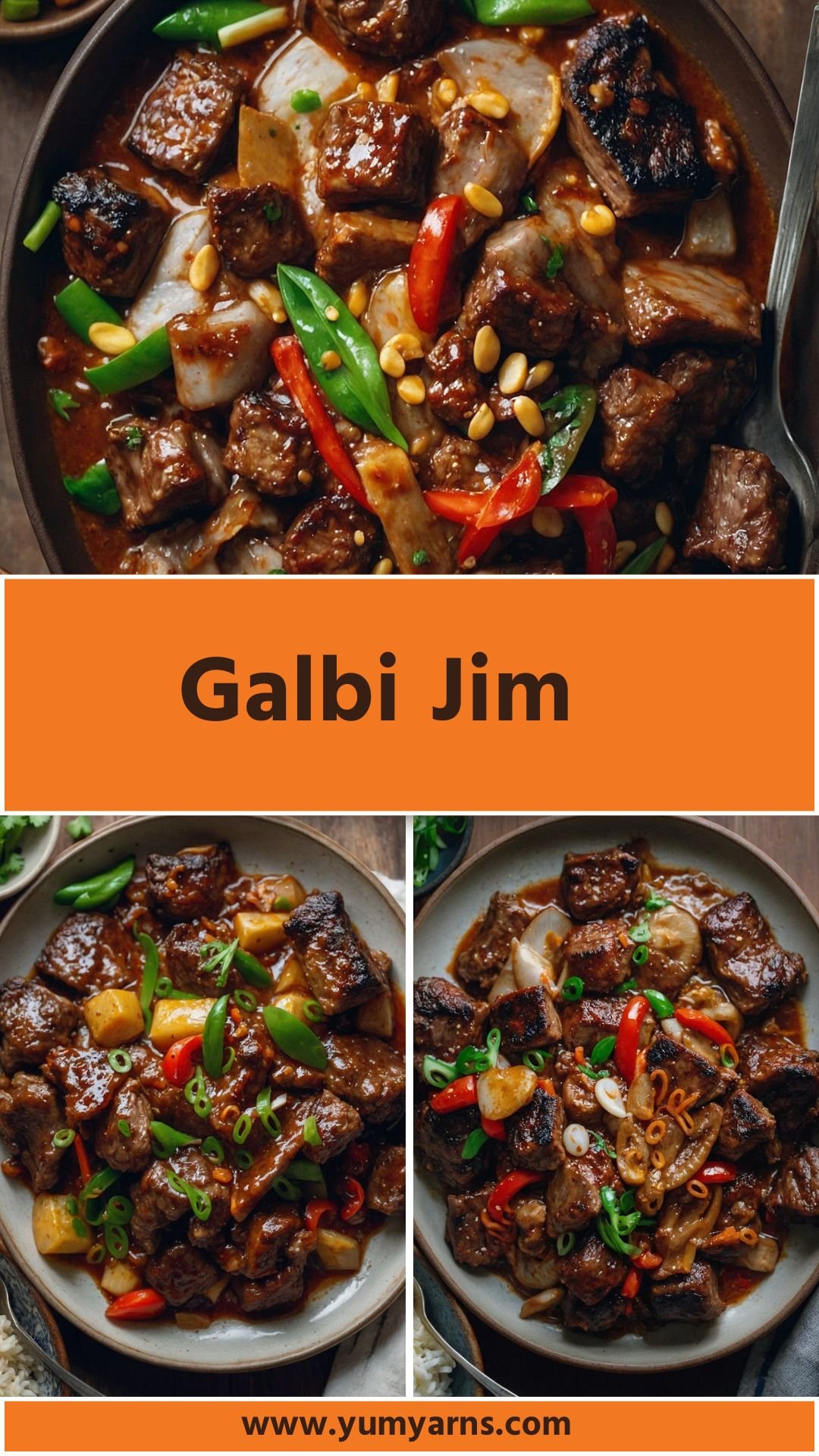As I sat outside one sunny afternoon, friends gathered around a simple picnic table, I was reminded of the power of food to bring people together. The sight of a steaming pot of Galbi Jim taking center stage instantly sparked conversations, laughter, and hungry anticipation.
The rich aroma wafting through the air was enough to make anyone’s stomach growl. I kicked things off by serving it alongside fluffy rice and a crisp kimchi. The combination was sublime.

What is Galbi Jim?
Galbi Jim is a traditional Korean braised beef short rib dish, characterized by its deep, savory flavors and tender meat that falls off the bone. This dish is a celebration of hearty ingredients, slow-cooked to perfection.
It’s not just a meal; it embodies the spirit of hospitality and family gatherings in Korean culture. Deeply satisfying, it pairs flawlessly with rice, pickled veggies, and even some refreshing lettuce wraps.
You will also like the following Lunch and Dinner recipes!
The Ingredients
Before diving into the cooking process, let’s look at the key players that make Galbi Jim irresistibly delicious.
- 5 pounds bone-in short ribs: The backbone of the dish. They provide rich flavor and tender meat.
- 2 ½ cups water: To create the braising liquid that will slowly cook the beef.
- ¾ cup soy sauce: For a savory umami punch.
- ½ cup sugar: Balances the saltiness of the soy sauce and adds depth to the flavor.
- 1 peeled and grated Asian pear: This unique ingredient tenderizes the meat and adds a hint of sweetness.
- 3 minced garlic cloves: Essential for that aromatic flavor.
- 2 tablespoons mirin: A touch of sweetness and depth.
- 1 teaspoon freshly ground black pepper: Adds a subtle heat.
- 1 tablespoon sesame oil: Provides a fragrant richness.
- 2 medium Yukon potatoes, peeled and cut into 2-inch pieces: Adds heartiness.
- 2 carrots, peeled and cut into 2-inch pieces: For sweetness and vibrant color.
- ½ Korean radish, peeled and cut into 2-inch pieces: A traditional addition that infuses flavor.
- 4 ounces shiitake mushrooms, stemmed and sliced in half: Earthy flavor and texture.
- Garnish: 2 green onions, thinly sliced for a fresh finish.

How to Make Galbi Jim
Making Galbi Jim is straightforward but requires some time to let the flavors develop. This dish is perfect for a slow weekend.
Step 1: Prepare the Short Ribs
Start by soaking the short ribs in cold water for about 30 minutes. This helps draw out excess blood and other impurities. Afterwards, rinse them well. Placing the ribs in a pot or deep pan will get you set up for the braising process.
Step 2: Make the Marinade
In a bowl, combine the soy sauce, sugar, grated Asian pear, minced garlic, mirin, black pepper, and sesame oil. This sweet and savory mixture will give life to the dish. Pour this marinade over the ribs, ensuring they’re well-coated.
Step 3: Add Water and Vegetables
Pour 2 ½ cups of water into the pot with the marinated ribs. Then, layer in the Yukon potatoes, carrots, Korean radish, and shiitake mushrooms. This step is key. The vegetables not only cook with the meat but also soak up those luscious flavors.
Step 4: Slow Cook the Galbi Jim
Cover the pot and bring it to a boil. After boiling, reduce to a simmer, keeping the lid on. Let it cook for about 2 and a half hours. You’re looking for the meat to become tender and the flavors to meld beautifully. Don’t rush this part! Take a break, enjoy a snack, or catch up on your favorite show.
Step 5: Final Adjustments and Serving
After the cooking time, taste the sauce. This is your chance to adjust. If you need more sweetness, sprinkle in a touch of sugar. If it’s too salty or rich, add a splash more water. Remove the pot from heat, and let it sit for at least 20 minutes to let the flavors settle.
Notes
Here are a few tips to elevate your Galbi Jim:
- Rest the meat: Letting it sit after cooking helps redistribute juices, leading to better flavor.
- Adjust sweetness: Taste as you go. If the sauce becomes too salty or strong, a little sugar can go a long way.
- Let it chill: If you have time, refrigerate overnight. The flavors become more complex as they meld.
- Serve hot: It tastes best fresh from the stove. Warm up leftovers gently to maintain tenderness.
- Cook with love: Enjoy the process! It makes a difference when you’re in the kitchen having fun.
Storage Tips
Galbi Jim is a dream when it comes to leftovers. You can store it in an airtight container in the fridge for up to 3 days. If you want to keep it longer, freeze it for up to 3 months. Thaw and reheat gently on the stove when you’re ready to dig in again.
Nutrition Information
A single serving of Galbi Jim contains roughly:
- Calories: 500
- Protein: 40g
- Carbohydrates: 30g
- Fat: 25g
The nutrient composition may vary depending on the specific ingredients used and cooking methods. It’s a hearty dish, loaded with protein and complemented by nutritious vegetables.
Serving Suggestions
Galbi Jim pairs well with a variety of sides. Here are some delightful ideas:
- Steamed Rice: Fluffy white rice is a classic pairing. It soaks up the sauce beautifully.
- Kimchi: This fermented side adds a refreshing contrast with a spicy kick.
- Pickled Radish: Bright and tangy, it cuts through the richness of the dish.
- Lettuce Wraps: Serve with crisp lettuce leaves so diners can create their own wraps.
- Korean Pancakes: A savory pancake makes a great accompaniment. The texture complements the tender meat.

What Other Substitutes Can I Use in Galbi Jim?
Looking to mix things up? Consider these substitutions:
- Brisket: A leaner cut with great flavor. Adjust cooking time for tenderness.
- Tofu: For a vegetarian take, use firm tofu. It will absorb the flavors beautifully.
- Beef Shank: A flavorful option that can add depth to the dish.
- Chicken Thighs: If you’re after lighter protein, chicken thighs braise well.
- Mushroom variety: Swap shiitake for your favorite, such as portobello or button, for different textures.

Galbi Jim
Equipment
- Bowl
- Pot
Ingredients
- 5 pounds bone-in short ribs: The backbone of the dish. They provide rich flavor and tender meat.
- 2 ½ cups water: To create the braising liquid that will slowly cook the beef.
- ¾ cup soy sauce: For a savory umami punch.
- ½ cup sugar: Balances the saltiness of the soy sauce and adds depth to the flavor.
- 1 peeled and grated Asian pear: This unique ingredient tenderizes the meat and adds a hint of sweetness.
- 3 minced garlic cloves: Essential for that aromatic flavor.
- 2 tablespoons mirin: A touch of sweetness and depth.
- 1 teaspoon freshly ground black pepper: Adds a subtle heat.
- 1 tablespoon sesame oil: Provides a fragrant richness.
- 2 medium Yukon potatoes peeled and cut into 2-inch pieces: Adds heartiness.
- 2 carrots peeled and cut into 2-inch pieces: For sweetness and vibrant color.
- ½ Korean radish peeled and cut into 2-inch pieces: A traditional addition that infuses flavor.
- 4 ounces shiitake mushrooms stemmed and sliced in half: Earthy flavor and texture.
- Garnish: 2 green onions thinly sliced for a fresh finish.
Instructions
Step 1: Prepare the Short Ribs
- Start by soaking the short ribs in cold water for about 30 minutes. This helps draw out excess blood and other impurities. Afterwards, rinse them well. Placing the ribs in a pot or deep pan will get you set up for the braising process.
Step 2: Make the Marinade
- In a bowl, combine the soy sauce, sugar, grated Asian pear, minced garlic, mirin, black pepper, and sesame oil. This sweet and savory mixture will give life to the dish. Pour this marinade over the ribs, ensuring they’re well-coated.
Step 3: Add Water and Vegetables
- Pour 2 ½ cups of water into the pot with the marinated ribs. Then, layer in the Yukon potatoes, carrots, Korean radish, and shiitake mushrooms. This step is key. The vegetables not only cook with the meat but also soak up those luscious flavors.
Step 4: Slow Cook the Galbi Jim
- Cover the pot and bring it to a boil. After boiling, reduce to a simmer, keeping the lid on. Let it cook for about 2 and a half hours. You’re looking for the meat to become tender and the flavors to meld beautifully. Don’t rush this part! Take a break, enjoy a snack, or catch up on your favorite show.
Step 5: Final Adjustments and Serving
- After the cooking time, taste the sauce. This is your chance to adjust. If you need more sweetness, sprinkle in a touch of sugar. If it’s too salty or rich, add a splash more water. Remove the pot from heat, and let it sit for at least 20 minutes to let the flavors settle
Notes
- Let it chill: If you have time, refrigerate overnight. The flavors become more complex as they mRest the meat: Letting it sit after cooking helps redistribute juices, leading to better flavor.
- Adjust sweetness: Taste as you go. If the sauce becomes too salty or strong, a little sugar can go a long way.
- eld.
- Serve hot: It tastes best fresh from the stove. Warm up leftovers gently to maintain tenderness.
- Cook with love: Enjoy the process! It makes a difference when you’re in the kitchen having fun.
Nutrition
Frequently Asked Questions
Can I use boneless short ribs?
Yes, boneless short ribs can work. They’ll cook faster and maintain similar flavors. Adjust the cooking time accordingly.
Is Galbi Jim spicy?
Traditionally, it’s not spicy. The flavor profile leans more on sweet and savory. If desired, you can add a dash of gochujang (Korean chili paste) for heat.
Can I make it in a slow cooker?
Absolutely! Sear the ribs first in a pan, then transfer to a slow cooker. Cook on low for about 6-8 hours.
What wines pair well with Galbi Jim?
A light red wine such as Pinot Noir or a fruity white like Riesling can complement the dish beautifully.
What do I do if my sauce is too thin?
If the sauce is runny, mix a tablespoon of cornstarch with water and stir it into the pot. Cook for a few minutes until thickened.
Conclusion
Galbi Jim embodies comfort and connection. With each tender bite, there’s something healing and nostalgic. Cooking this dish, with the love and care it deserves, leads to flavors that turn a simple meal into a cherished memory.
So next time you gather around the table, remember that great food has the power to create lasting bonds. Roll up your sleeves, grab your ingredients, and embark on a culinary journey that celebrates tradition, flavor, and togetherness. Bon appétit!

